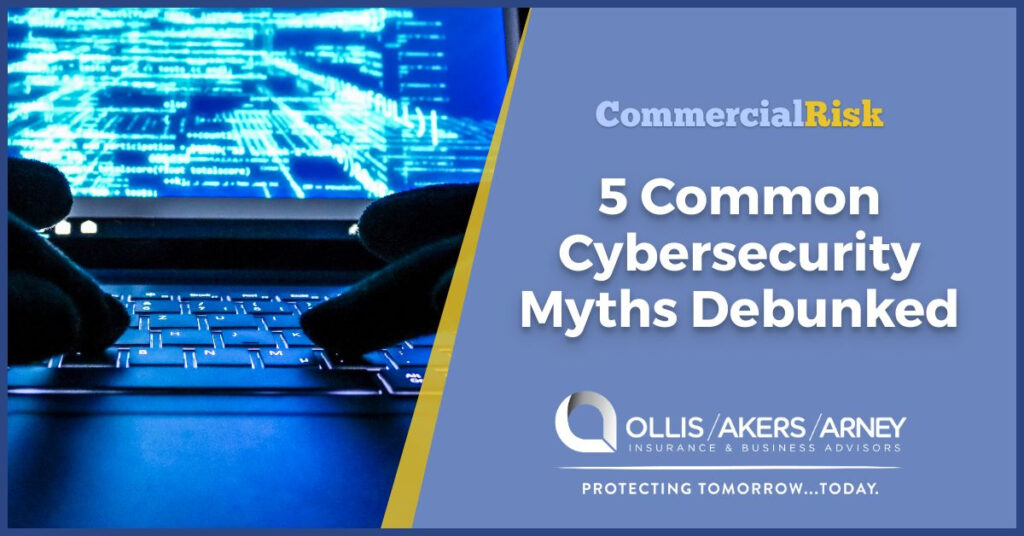Cybersecurity consists of strategies implemented to help protect organizations from cyberattacks and related losses. Such defense has become increasingly important as businesses of all sizes and sectors expand their reliance on technology and other digital services. Yet, there are several misconceptions about cybersecurity that diminish the value of effective mitigation strategies and may leave organizations vulnerable to cyberthreats. Here are five common cybersecurity myths, debunked:
Myth #1: Only large corporations need cybersecurity protocols.
A common misconception is that adopting proper cybersecurity measures only makes sense for large corporations. While large organizations can be susceptible to cyberattacks, this doesn’t mean small businesses are immune to them. On the contrary, some cybercriminals consider small organizations more attractive targets because they are more likely to have weaker cybersecurity measures, which simplifies the overall attack process.
Myth #2: Basic cybersecurity procedures are sufficient to protect against possible threats.
For certain organizations, cybersecurity consists of a few basic protocols, such as deploying firewalls and installing antivirus software. These can prove useful, but adopting a single-layered approach probably isn’t effective in minimizing all threats, including brute force incidents and social engineering scams. As the cyber risk landscape changes, organizations’ mitigation strategies should follow suit. Leveraging a wide range of multilayered protective measures (e.g., multifactor authentication, endpoint detection and response solutions, email authentication technology, patch management plans and data backup systems) can better equip organizations to address their digital exposures.
Myth #3: Cybersecurity measures aren’t worth the cost for small businesses.
Small organizations may initially be less inclined to invest in cybersecurity due to the expenses. This likely stems from these organizations thinking that cybersecurity benefits aren’t worth their costs. However, small businesses are frequent targets for cyberattacks, and these businesses are more likely to face financial ruin in the aftermath of such attacks. Considering this, investing in sufficient mitigation strategies could make all the difference in helping these small businesses avoid major losses and prevent financial devastation from cyber incidents.
Myth #4: Cybersecurity is only the IT department’s job.
Although IT professionals play a major role in implementing adequate cybersecurity measures, the most effective cybersecurity models involve companywide participation. Without this, organizations are more likely to have poor cyber hygiene and awareness. As such, it’s imperative that organizations foster a culture that encourages everyone to take responsibility for cybersecurity. This entails having company executives lead by example, training employees to detect and defend against prevalent cyberthreats, and recognizing those who demonstrate a continued commitment to security.
Myth #5: Cyberthreats are always external.
In addition to external sources, cyberthreats can arise from insiders, including employees, vendors or third-party collaborators. Due to their unique privileges, insider threats can potentially compromise organizations’ most valuable assets and leave the business more susceptible to a range of cyber incidents. In fact, a recent survey conducted by IT platform Cybersecurity Insiders found that the average insider event costs over $755,000. Therefore, it’s vital for organizations to account for both external and internal threats when developing their cybersecurity measures.
Accurate information is essential to an effective cybersecurity program. For more risk management guidance, contact us today.
A recent study by Accenture, an international IT services and consulting company, found that 43% of all cyberattacks target small businesses. With this in mind, it’s clear that cybersecurity measures are necessary for organizations of all sizes.
This document is not intended to be an exhaustive source of information nor should any discussion or opinions be construed as legal advice. Readers should consult legal counsel or a licensed insurance professional for appropriate advice. © 2024 Zywave, Inc. All rights reserved.


